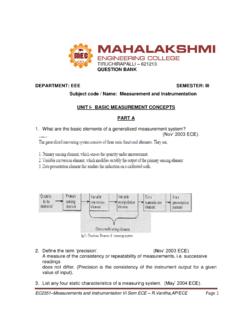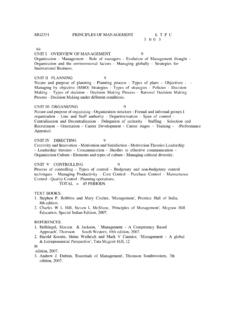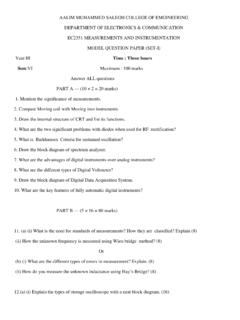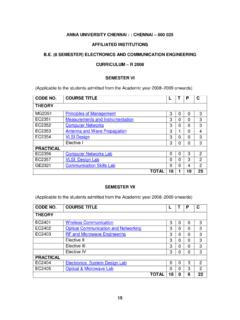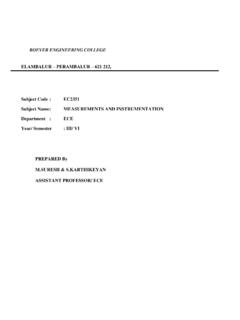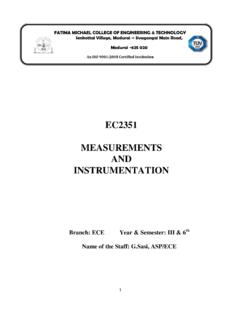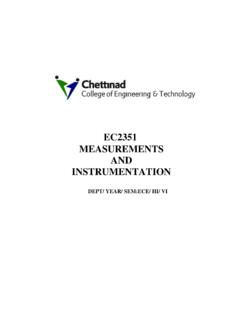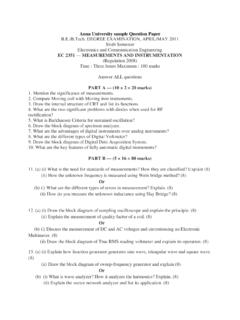Transcription of MAHALAKSHMI
1 ec2351 Measurements and instrumentation VI Sem ECE ,AP/ECE Page 1 MAHALAKSHMI ENGINEERING COLLEGE TIRUCHIRAPALLI 621213 QUESTION BANK DEPARTMENT: ECE SEMESTER: IV Subject code / Name: ec2351 / measurement and instrumentation UNIT-III SIGNAL GENERATORS AND ANALYZERS PART A 1. What is Barkhausen Criteria for sustained oscillation? (APRIL/MAY 2011) 2. Draw the block diagram of spectrum analyzer. (APRIL/MAY 2011) ec2351 Measurements and instrumentation VI Sem ECE ,AP/ECE Page 2 3. What is intermodulation distortion? (Nov/DEC 2012) Intermodulation or intermodulation distortion (IMD) is the amplitude modulation of signals containing two or more different frequencies in a system with nonlinearities. The intermodulation between each frequency component will form additional signals at frequencies that are not just at harmonic frequencies (integer multiples) of either, but also at the sum and difference frequencies of the original frequencies and at multiples of those sum and difference frequencies.
2 Intermodulation is caused by non-linear behavior of the signal processing being used. 4. In a sweep frequency generator tow oscillator on with the frequency range of 3 to 5 GHz is heterodyne with second oscillator having the fixed frequency of output the output frequency varies? (Nov/DEC 2012)(May 2004 ECE). The range of output frequency is 0-2G Hz. 5. What is wave analyzer? (Nov/DEC 2011) A wave analyzer in an instrument designed to measure the relative amplitude of single frequency component in a complex or distorted waveform 6. What is the use of attenuator in sine wave generator? Nov/DEC 2011 Why We Need To Use Digital RLC Meters ? RLC Meter Is Used To Measure Q Factor Of L And C. 7. Briefly Explain About Frequency Synthesizer . The Frequency Generators Are Of Two Types. 1. One Is Free Running Frequency Generators In Which The Output Can Be Tuned Continuously Either Electronically Or Mechanically Over A Wide Frequency Range.
3 The Generators Discussed Uptill Now Are Of This Type. 2. The Second Is Frequency Generator With Frequency Synthesis Technique. The Synthesis Means To Use A Fixed Frequency Oscillator Called Reference Oscillator Or Clock And To Drive The Wide Frequency Range In Steps From The Output Of The Reference Oscillator The Stability And Accuracy Of Free Running Frequency Generator Is Poor While Frequency Synthesizers Provide Output Which Is Arbitrarily Selectable , Stable And Accurate Frequency 8. What are the signal sources? What are the desirable characteristics of a signal. (May 2004 ECE). Signal source is equipment, which accepts an electrical signal from a battery and convert it into output signal. This output signal is a cyclic repetition of electrical voltage or current having predetermined frequency, waveform and amplitude. It can generate a variety of waveform including sine wave, square wave, triangular wave.
4 Characteristics: (i) The frequency of the signal should be stable. ec2351 Measurements and instrumentation VI Sem ECE ,AP/ECE Page 3 (ii) The amplitude should be controllable from very small to large values. (iii) The output signal should be free from distortion. 9. What do you mean by heterodyne principle? (May 2005 ECE). Heterodyning mixing is the input signal to be analyzed is mixed to a higher intermediate frequency (IF) by an internal local oscillator. 10. Define total harmonic distortion or distortion factor (May 2005/ Nov 2003 ECE). The total harmonic distortion is measured in terms of the harmonic content of the wave. It is also called as distortion factor. THD= [ (harmonics)2]12/fundamental 11. Define harmonic distortion. (May 2003/May 2006 ECE) When a sinusoidal input signal is applied to an electronic device like amplifier, the o/p of amplifier should be sinusoidal waveform.
5 However it is seen that the o/p that the o/p is not the exact replica of the i/p because of various types of distortion that occur. The distortion may be result of the inherent non-linear characteristics of the different components used in the electronic circuit. This non-linear behavior introduces harmonics of the fundamental frequency in the output and the resultant distortion is called harmonic distortion. 12. Give any two applications of wave analyzer. (May 2006 ECE) (i) To measure the harmonic distortion of an amplifier. The contribution of each harmonic to the total distortion also can be determined. (ii) To measure relative amplitudes of signal frequency components in a complex waveforms. 13. What is spectrum analyzer? (May 2006 ECE) The study of energy distribution of a signal as a function of frequency is called as spectrum analysis.
6 The instrument which graphically presents an energy distribution of the signal as a function of frequency on the is called as spectrum analyzer. 14. Mention any four signal generating instruments. (May 2006 ECE) i. Sine-wave generator. ii. Square wave generator. iii. Sweep generator. iv. Frequency synthesizer. 15. What are the requirements of signal generator? (Nov 2006 ECE) The requirements of signal generator are (i) The frequency of the signal should be stable. (ii) The amplitude should be controllable from very small to large values. (iii) The output signal should be free from distortion. ec2351 Measurements and instrumentation VI Sem ECE ,AP/ECE Page 4 16. What is a real time spectrum analyzer? (Nov 2006 ECE) The real time spectrum analyzer is non scanning type. Its function is to present he effect of changes in all input frequencies on its spectrum display instantly.
7 It is not used at RF or microwave frequencies, used only in the audio frequencies. The range of real time spectrum analyzer is from 50Hz-10 KHz. 17. Give the function of attenuator in signal generator. (May 2007) An attenuator is a device that will reduce the power level of signal for which the amplitude is easily measured and calibrating the attenuator stops. Moreover the attenuator reduces the power of an input such that the ratio of the input power to the output power is a constant. 13. What are the drawbacks of tuned circuit analyzers? (May 2007) i) At low frequencies, very large values for L and C are required and their physical size becomes rather impractical. ii) Harmonics of the signal frequency are often very close in frequency so that it becomes extremely difficult to distinguish between them. 14. How are the digital voltmeter classified?(May 2007-R01) Digital voltmeters are classified as: i) Ramp type DVM ii) Integrating DVM iii) Continuous-balance DVM iv) Successive-approximation DVM 15.
8 What is the need for guarding? (May 2007-R01) The effects of leakage paths on the measurement are usually removed by guarding circuit. 16. Write the function of distortion analyzer. (May 2007-R01) The function of distortion analyzer is to determine the harmonic content of a waveform. 17. State the need for isolation between the signal generator output and oscillator? How can this be done?(Nov 2007) The main purpose of providing isolation between signal generator and isolator is to reduce output distortion. This can be achieved by feedback. 18. How is voltage converted to frequency in V/F Conversion.(May 2008) ec2351 Measurements and instrumentation VI Sem ECE ,AP/ECE Page 5 Integrating type digital voltmeter employs an integration technique which uses a voltage to frequency conversion. This converter functions as a feedback control system which governs the rate of pulse generation in proportion to the magnitude of input voltage.
9 19. How are signal generators classified? (Nov 2009) Signal generators are classified as square wave generator, function generator, sweep generator. 20. What is the dynamic range of a spectrum analyser if the noise level of the display is equal to -80 dB and two -10 dB signal produce third order inter modulation products that just appear above the noise? (Nov 2009) Refer book 21. List the application of the wave analyzer..(May 2010) A wave analyzer is used to measure the relative amplitude of signal frequency component in a complex waveform. These are applied industrially in the field of reduction of sound and vibration generated by rotating electrical machine and apparatus. 22. What is the difference between a wave analyzer and a harmonic distortion analyzer? A wave analyzer is an instrument that measures amplitudes of the harmonic components of complex signal.
10 A harmonic distortion analyzer is an instrument that measures total harmonic distortion by determining the harmonic components of a given waveform. 23. State the applications of spectrum analyzer. It is used for Observing purity of a signal Analyzing modulated signals Studying harmonic components of a signal Finding the intermodulation content. 24. Give two applications of function generators. It is used for Generating sine, square, triangle, sawtooth waveforms etc. Modulating amplitude, frequency and pulse width of the signal. 25. What is harmonic distortion? It is a form of distortion caused by a signal passing through a non-linear system in which harmonics are added to the fundamental signal. 26. Define rise time and fall time of a pulse. ec2351 Measurements and instrumentation VI Sem ECE ,AP/ECE Page 6 Rise time : It is the time required for a pulse to rise from 10 to 90% of its normal /final amplitude.
